Well, the weather has turned cold - it even snowed today - and it's definitely time for comfort food. My favorite comfort foods include braises, and pot roast more than fills the bill. Paul asked me last night if I would make him some pot roast soon and I decided to git'er done. It needed to include lots of root vegetables for flavor, texture and good nutrition and this recipe has all of that. This recipe is just a guideline, and you might not like beets or parsnips, but they really add to the quality of the dish.
2 1/2 pounds chuck roast salt and pepper
1+ tablespoons olive oil
1 cup medium chop yellow onions
1/2 cup medium chop carrots
1/2 cup medium chop celery
1/2 cup or so red wine
1 1/2 quarts organic beef broth
1 medium golden beet, peeled, cut up into 3/4" pieces
1 medium parsnip, peeled, cut up into 3/4" pieces
4 medium yukon gold potatoes, peeled, cut up in 1" pieces
1 cup baby carrots, or cut up carrots
1/8 teaspoon or so cayenne pepper
5 oz. frozen pearl onions
5 oz. frozen petite peas
Preheat oven to 325° with rack in lower third. Over medium heat, brown the chuck roast on all sides with olive oil in an a 5 1/2 quart dutch oven, preferably enameled cast iron, such as LeCreuset. Remove the roast to a plate and add the chopped onions, celery and carrots. Sweat until tender, about 5 minutes, then add the red wine and cook to reduce to nearly dry.
Put the chuck roast back in the pan, add 1 quart broth, about half way or so up the side of the roast. Bring to a simmer, then cover and place in the oven. Braise 2 hours or so, turning roast once. Add the beet, parsnip and potato pieces, along with the baby carrots and cayenne. You will probably want to add beef broth to bring liquid level back up. Back in the oven for 1 1/2 hours, check beef for tenderness; it should be fork-tender. Put the pot on the stovetop, burner on medium, and add pearl onions and peas. Simmer for 5 minutes or less, to finish off the dish. Serve.

Feel free to add more beef broth - the root vegetables absorb liquid. Beets are very dense and probably won't cook through in allotted time and will be firm. If you want them tender, add them at least 1/2 hour before the other veggies. Cayenne in moderation adds depth of flavor, not heat; it's wonderful in braises.
Notes on olive oil: I'm going to admit something to you. I've been using cheap olive oil, ignoring the probability that the evoo I've been buying at Trader Joe's isn't filling the nutritional bill. Yesterday I went to an olive oil tasting room in Fairfield with some friends and was given an education. Presuming they weren't filling me full of bull, good olive oil is supposed to have lots of polyphenols - the good stuff. You can tell if your olive oil has them if when you taste it, you get a peppery taste and sensation in the back of your throat. No pepper, no poly-p's, just oil. I've had that peppery experience in other tasting rooms, and I quite like it. SePay Groves also has a cooking oil with olive and safflower oils and a high level of polyphenols, and importantly, a high smoke point. I bought the organic Tuscan olive oil for dipping and salads and the cooking oil for, well, cooking. I'm guessing that the California olive oils being produced are the good stuff, but do your homework. I will. (By the way, I tasted my cheap oil and yep, no pepper taste!)
Coming up - for the holidays I am going to make chocolate almond toffee real soon, using Lyle's Golden Syrup instead of corn syrup, as promised. Wish me luck!



































